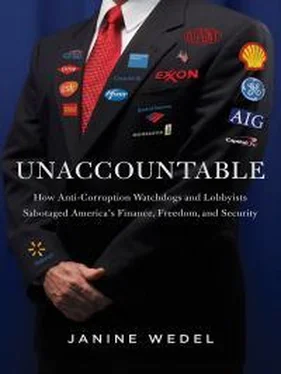48. Piotr Ozierański writes: “There are strong indications that key patterns of relationships among social actors, particularly those related to the mechanisms of pharmaceutical lobbying, take similar form in the US, the UK and in other countries of the ‘Old European Union.’ . . .” (Piotr Ozierański, Who Rules Postcommunism? The Case of Drug Reimbursement Policy in Poland . Cambridge University dissertation, 2011, p. 7.) See also Piotr Ozierański, Martin McKee, and Lawrence King, “Pharmaceutical lobbying under postcommunism: universal or country-specific methods of securing state drug reimbursement in Poland?” Health Economics, Policy, and Law, vol. 7, no.2, April 2012, pp. 175-195.
49. Sergio Sismondo, “Key Opinion Leaders and the Corruption of Medical Knowledge: What the Sunshine Act Will and Won’t Cast Light On,” Journal of Law, Medicine & Ethics, vol. 41, no. 3, 2013, p. 639.
50. Ibid.
51. Elliott, op. cit., p. 4.
52. Piotr Ozierański, Who Rules Postcommunism?, op. cit. See also Piotr Ozierański, Martin McKee, and Lawrence King, “Pharmaceutical lobbying under postcommunism,” op. cit.
53. Sismondo, op. cit., p. 639. See also: Lazarsfeld, Berelson, and Gaudet, op. cit.; Katz and Lazarsfeld, op. cit.
54. Elliott, op. cit., pp. 4-5.
55. Elliott, op. cit., p. 5, adds: “Drug companies are prohibited from promoting a drug for conditions other than the ones for which the FDA has approved it, but because these off-label uses are often highly profitable, many companies have found creative ways of getting around the prohibition.”
56. Sismondo, op. cit., p. 639.
57. Sismondo cites Jennifer R. Fishman, “Manufacturing Desire: The Commodification of Female Sexual Dysfunction.” Social Studies of Science , vol. 34, no. 2, 2004, pp. 187-218.
58. Andrew Lakoff, “The Anxieties of Globalization: Antidepressant Sales and Economic Crisis in Argentina.” Social Studies of Science, vol. 34, no. 2, April, 2004, pp. 262-263.
59. Elliott, op. cit., p. 2.
60. Sismondo, op. cit., p. 639.
For additional support of these points, see also: Philip Mirowski and Robert Van Horn, “The Contract Research Organization and the Commercialization of Scientific Research.” Social Studies of Science , vol. 35, no. 4, 2005, pp. 503-534; Hans Melander, Jane Ahlqvist-Rastad, Gertie Meijer, and Björn Beermann, “Evidence B(i)ased Medicine—Selective Reporting from Studies Sponsored by Pharmaceutical Industry: Review of Studies in New Drug Applications,” BMJ, no. 326, May 29, 2003, pp. 1171-1173; Sergio Sismondo, “Ghost Management: How Much of the Medical Literature Is Shaped behind the Scenes by the Pharmaceutical Industry?” PLoS Medicine , vol. 4, no. 9, 2007, p. e286; Sergio Sismondo, “Ghosts in the Machine: Publication Planning in the Medical Sciences,” Social Studies of Science, vol. 39, no. 2, 2009, pp. 171-198; and Peter C. Gøtzsche, Asbjørn Hróbjartsson, Helle Krogh Johansen, Mette T. Haahr, Douglas G. Altman, and An-Wen Chan, “Ghost Authorship in Industry-Initiated Randomised Trials,” PLoS Medicine, vol. 4, no. 1, 2007, pp. 47-52.
61. Elliott, op. cit., p. 2.
Elliott adds: While “hunger for status . . . motivates many academic physicians to work for industry,” to maintain their status, “those physicians must also cultivate the perception of independence” (Elliott, op. cit., p. 6).
62. Piotr Ozierański and Lawrence King. “The Persistence of Cliques in the Postcommunist State,” 2014, forthcoming paper.
63. Piotr Ozierański and Lawrence King, Who Rules Postcommunism? The Case of Drug Reimbursement Policy in Poland, 2014, forthcoming paper.
64. The legislation was introduced in 2009, but failed to pass at that time (see: http://thomas.loc.gov/cgi-bin/bdquery/z?d111:s.00301). However, it was incorporated into the 2010 Patient Protection and Affordable Care Act, Section 6002 (Bill text: https://www.govtrack.us/congress/bills/111/hr3590/text). See also: http://www.gpo.gov/fdsys/pkg/FR-2013-02-08/pdf/2013-02572.pdf, http://www.aafp.org/news/government-medicine/20130215sunshineactrule.html. See also Elliott, op. cit., p. 7.
65. Elliott, op. cit., p. 6.
66. Eric Sagara, Charles Ornstein, Tracy Weber, Ryann Grochowski Jones, and Jeremy B. Merrill, “Dollars for Docs: How Industry Dollars Reach Your Doctors” (http://projects.propublica.org/docdollars/).
67. Beginning in 2010, ProPublica found in a project focused on the United States, in a series called “Dollars for Docs,” that the tangle of ties between physicians and the pharmaceutical and medical-device industry was still vast and stretching into multiple . See: Eric Sagara, Charles Ornstein, Tracy Weber, Ryann Grochowski Jones, and Jeremy B. Merrill, “Dollars for Docs: How Industry Dollars Reach Your Doctors” (http://projects.propublica.org/docdollars/).
There were the medical societies with nearly unimpeachable-sounding names that had turned into conduits of cash from Big Pharma companies to physicians; the physicians on company payrolls who had misconduct on their records and were presumably more desperate for the cash that drug companies were pleased to provide; the story that showed even schools with rigorous ethical codes had faculty who were ignoring rules and giving paid promotional talks for drug and device companies (Tracy Weber and Charles Ornstein, “Med Schools Flunk at Keeping Faculty Off Pharma Speaking Circuit.” ProPublica , December 19, 2010 [http://www.propublica.org/article/medical-schools-policies-on-faculty-and-drug-company-speaking-circuit]; Charles Ornstein, Tracy Weber, and Dan Nguyen, “Docs on Pharma Payroll Have Blemished Records, Limited Credentials.” ProPublica , October 18, 2010 [http://www.propublica.org/article/dollars-to-doctors-physician-disciplinary-records]).
And there were the whistleblower lawsuits that exposed blatant attempts by companies to pay doctors who then would push their preferred drugs into the hands of patients (Charles Ornstein and Tracy Weber, “Lawsuits Say Pharma Illegally Paid Doctors to Rush Their Drugs.” ProPublica , October 18, 2010 [http://www.propublica.org/article/lawsuits-say-pharma-illegally-paid-doctors-to-push-their-drugs]).
68. Eric Sagara, Charles Ornstein, and Ryann Grochowski Jones, “As Full Disclosure Nears, Doctors’ Pay for Drug Talks Plummets.” ProPublica , March 3, 2014 (http://www.propublica.org/article/as-full-disclosure-nears-doctors-pay-for-drug-talks-plummets).
69. Elliott, op. cit., p. 7.
70. Conversation with Piotr Ozierański, June 26, 2014.
71. Sismondo, “Key Opinion Leaders,” op. cit., p. 636.
72. D. Nguyen, C. Ornstein, and T. Weber, “Dollars for Docs: How Industry Dollars Reach your Doctors.” ProPublica, available at http://projects.propublica.org/docdollars/ (last visited July 3, 2013).
73. Bob Davis, “In Washington, Tiny Think Tank Wields Big Stick on Regulation.” Wall Street Journal, July 16, 2004 (http://online.wsj.com/news/articles/SB108994396555065646).
74. Jane Mayer, “Covert Operations.” The New Yorker, August 30, 2010 (http://www.newyorker.com/reporting/2010/08/30/100830fa_fact_mayer?currentPage=all). See also http://www.kochfamilyfoundations.org/ProjectsMercatus.asp.
75. Mercatus Center (http://mercatus.org/all-people).
76. Mercatus Center (http://mercatus.org/all-publications/congressional-testimony); Mercatus Center (http://mercatus.org/video).
77. Lee Fang, “The Scholars Who Shill for Wall Street.” The Nation, October 23, 2013 (http://www.thenation.com/article/176809/scholars-who-shill-wall-street#).
78. Iibid.
79. Mercatus Center, “J.W. Verret” (http://mercatus.org/j-w-verret).
Читать дальше












